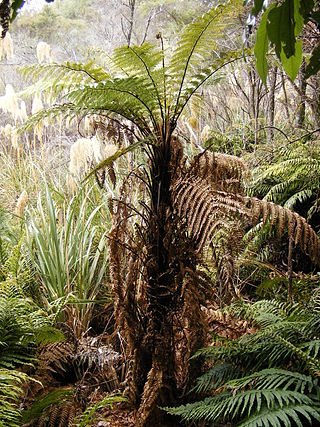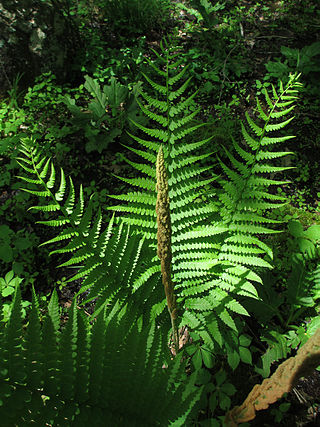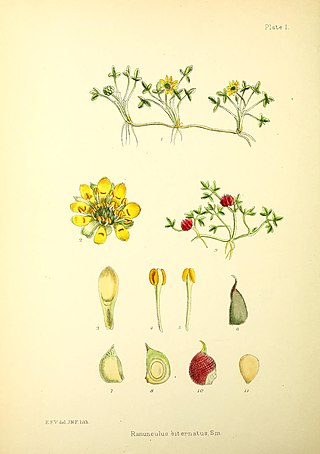
Dicksonia antarctica, the soft tree fern, Tasmanian Tree Fern or man fern, is a species of evergreen tree fern native to eastern Australia, ranging from south-east Queensland, coastal New South Wales and Victoria to Tasmania.

Sphaeropteris cooperi, synonym Cyathea cooperi, also known as lacy tree fern, scaly tree fern, or Cooper's tree fern, is a tree fern native to Australia, in New South Wales and Queensland.

Dicksonia squarrosa, the New Zealand tree fern, whekī or rough tree fern, is a common tree fern endemic to New Zealand. It has a slender black trunk that is usually surrounded by many dead brown fronds.

Alsophila dregei, synonym Cyathea dregei, is a widespread species of tree fern in southern Africa.

Adiantum aleuticum, the western maidenhair fern or Aleutian maidenhair, is a species of deciduous fern in the genus Adiantum.

Osmundastrum is genus of leptosporangiate ferns in the family Osmundaceae with one living species, Osmundastrum cinnamomeum, the cinnamon fern. It is native to the Americas and eastern Asia, growing in swamps, bogs and moist woodlands.

Hymenophyllum nephrophyllum, the kidney fern, is a filmy fern species native to New Zealand. It commonly grows on the forest floor of open native bush. Individual kidney-shaped fronds stand about 5–10 cm tall. In hot weather they shrivel up to conserve moisture, but open up again when the wet returns. This species has very thin fronds which are only four to six cells in thickness. In the Māori language they are also called raurenga.

Pteris tremula, commonly known as Australian brake, tender brake, tender brakefern, shaking brake is a fern species of the family Pteridaceae native to sheltered areas and forests in eastern Australia and New Zealand. It has pale green, lacy fronds of up to 2 meters in length. It is fast-growing and easy to grow in cultivation, but can become weedy.

Gleichenia dicarpa, commonly known as pouched coral fern or tangle fern, is a small fern of the family Gleicheniaceae found in eastern Australia, New Caledonia and New Zealand. It forms tangled thickets in wet places such as swamps and riverbanks.

Angiopteris evecta, commonly known as the king fern, giant fern, elephant fern, oriental vessel fern, Madagascar tree fern, or mule's foot fern, is a very large rainforest fern in the family Marattiaceae native to most parts of Southeast Asia and Oceania. It has a history dating back about 300 million years, and is believed to have the longest fronds of any fern in the world.

Hymenophyllum australe, commonly known as austral filmy fern, is a relatively large rupestral and epiphytic fern, indigenous to eastern Australia and New Zealand. It belongs to the unique Hymenophyllum genus, which are characterised by their thin membranous fronds that are seldom more than one cell thick, with the exception of regions over and around veins. Hymenophyllum australe is distinctive in that the fronds are typically thicker than other Hymenophyllum species, often being up to 2-3 cells thick.

Hymenophyllum flabellatum, the shiny filmy-fern, is a species of fern in the family Hymenophyllaceae. This delicate fern is commonly epiphytic and is between 5 and 25 cm in length. It is distinct, with its thin, one-celled thick, membranous leaves. It is from the family Hymenophyllaceae and is dispersed world wide. The species is dispersed highly throughout Tasmanian rainforests and in the south east of mainland Australia, with small pockets of the population seen in northern Queensland.

The wildlife of the Falkland Islands is quite similar to that of Patagonia. The Falkland Islands have no native reptiles or amphibians, and the only native land mammal, the warrah, is now extinct. However, a large number of bird species have been seen around the islands, and many of them breed on the smaller islands of the archipelago. Insects play a large role in the ecosystem of the islands, and over 200 species have been recorded. The waters around the Falkland Islands sustain many animals, including a large number of marine mammals. Three pinniped species breed on the islands.

Hymenophyllum tunbrigense, the Tunbridge filmy fern or Tunbridge filmy-fern, is a small, fragile perennial leptosporangiate fern which forms large dense colonies of overlapping leaves from creeping rhizomes. The common name derives from the leaves which are very thin, only a single cell thick, and translucent, giving the appearance of a wet film. The evergreen fronds are bipinnatifid, deeply and irregularly dissected, about 3 to 6 cm long, 2 cm across with dark winged stipes. In contrast to the similar H. wilsonii the fronds are more divided, flattened, appressed to the substrate and tend to have a bluish tint.
Tasmania is home to 'Australia’s largest cool temperate rainforests. Most of Tasmania’s rainforests occur in the North-West and throughout the North East highlands. Cool temperate rainforests typically have a heavy rainfall, cool climate, favor high altitudes and have a limited availability of light.

Dipteris conjugata is a species of fern in the family Dipteridaceae. It has a rhizome, and 2-3 tall stems with mid green or dark green fronds, which have several divisions to toothed lobes. It is grows in clearings, mountain ridges and in forest margins, from tropical and temperate Asia, northern Queensland in Australia and some islands in the Pacific Ocean. It has limited native medicinal uses.

Hymenophyllum rarum, the narrow filmy-fern, is a species of fern from the family Hymenophyllaceae. This thin-leaved fern is commonly found in New Zealand and Tasmania, growing in patches on rocks and is epiphytic on trees and tree ferns, growing in moist gullies or rainforests. A rather drought tolerant species often found at exposed sites ranging from coastal to montane areas. Forming extensive, interwoven and creeping patches with its thin long (creeping) rhizomes sparsely covered in red-brown hairs, easily recognised by its membranous grey-green fronds, the smooth margins of the pinnae, ultimate segments and indusia; and by the sunken sori in the uppermost segments of the uppermost pinnae. The species can be found throughout Tasmanian rainforests as well as occurring in New South Wales, Victoria and New Zealand on the North and South Islands as well as, Stewart, Chatham and Auckland Islands.
Acaena tenera, the lesser burnet, is a plant in the rose family Rosaceae. It is native to Patagonia and some subantarctic islands.

Ranunculus biternatus, the Antarctic buttercup, is a plant in the buttercup family Ranunculaceae. It is native to southern South America and some subantarctic islands.
Hymenophyllum axsmithii is an extinct species of fern in the family Hymenophyllaceae related to the modern hayscented ferns. The species is known from fossil fronds found in early Eocene sites of northern Washington state, United States, and central British Columbia, Canada. The species is included in Hymenophyllum subgenus Sphaerocionium, with a suggestion to be closest to a group of tropical species in the subgenus that are all specialized as sheltered epiphytes.

















